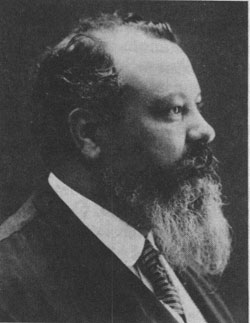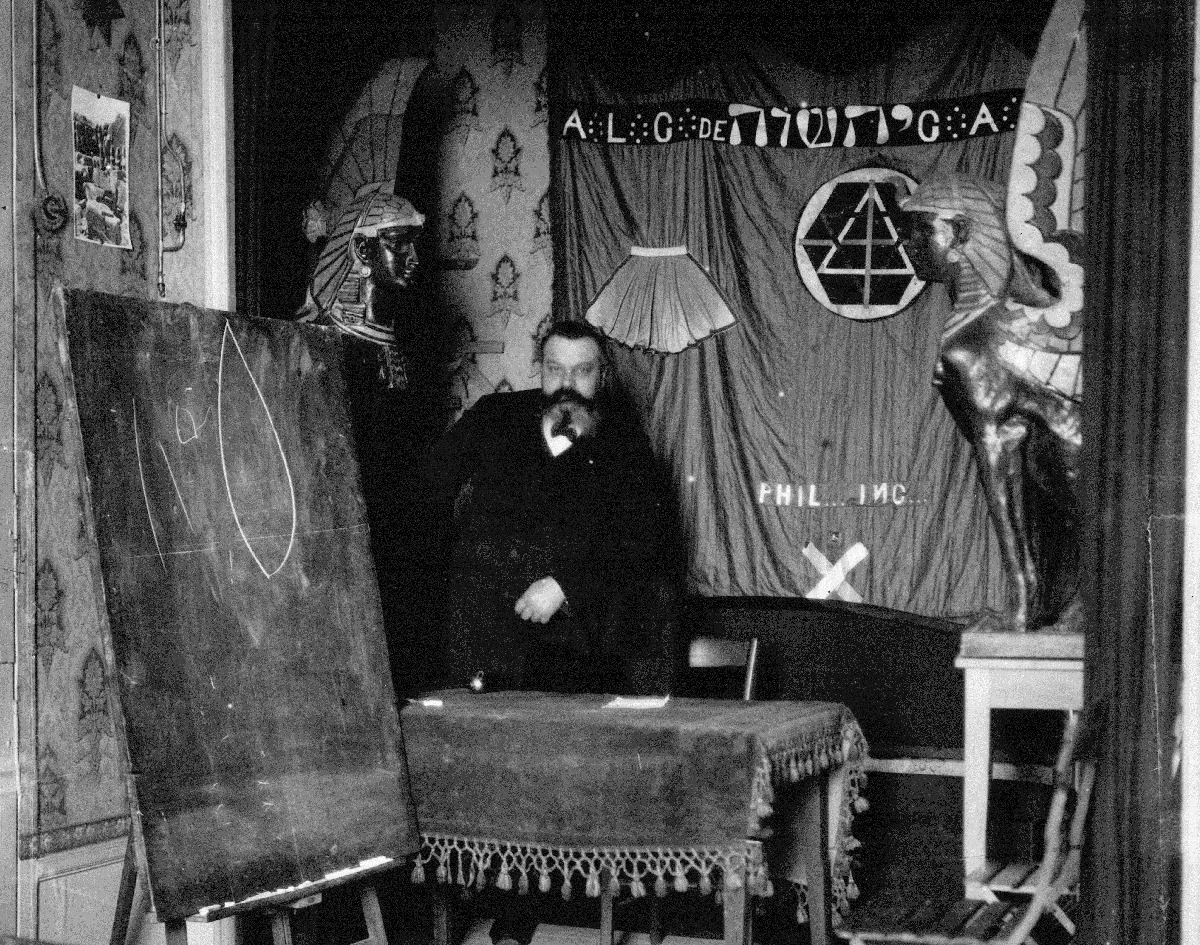Papus
Papus was the pseudonym of French author Gérard Anaclet Vincent Encausse (July 13, 1865 – 25 October 1916). Throughout his life, he worked as a physician, hypnotist, and popularizer of occultism.
Early life
Gerard Encausse was born at A Coruña in Galicia (Spain) on July 13, 1865, of a Spanish mother and a French father, Louis Encausse, a chemist. His family moved to Paris when he was four years old, and he received his education there.
As a young man, Encausse spent a great deal of time at the Bibliothèque Nationale studying the Kabbalah, tarot, ritual magic and alchemy, and the writings of Eliphas Lévi. He joined the French Theosophical Society shortly after it was founded by Helena Blavatsky in 1884–1885, but he resigned soon after joining because he disliked the Society's emphasis on Eastern occultism.
Despite his heavy involvement in occultism and occultist groups, Encausse managed to find time to pursue more conventional academic studies at the University of Paris. He received his Doctor of Medicine degree in 1894 upon submitting a dissertation on Philosophical Anatomy. He opened a clinic in the rue Rodin which was quite successful.
Physician to Tsar Nicholas
Encausse visited Russia three times, in 1901, 1905, and 1906, serving Tsar Nicholas II and Tsarina Alexandra both as physician and occult consultant. It has been incorrectly claimed that in October 1905, he conjured up the spirit of Alexander III (father of Tsar Nicholas), who prophesied that the Tsar would meet his downfall at the hands of revolutionaries. Encausse's followers allege that he informed the Tsar that he would be able to magically avert Alexander's prophecy so long as Encausse was alive. Nicholas kept his hold on the throne of Russia until 141 days after Papus' death.
Although Encausse seems to have served the Tsar and Tsarina in what was essentially the capacity of a mediumistic spiritual advisor, he was later curiously concerned about their heavy reliance on occultism to assist them in deciding questions of government. During their later correspondence, he warned them a number of times against the influence of Rasputin.
Career as author
Encausse's early readings in tarot and the lore of the Kabbalah in translation was inspired by the occult writings of Éliphas Lévi, whose translation of the Nuctemeron of Apollonius of Tyana" printed as a supplement to Dogme et Rituel de la Haute Magie (1855), provided Encausse with his pen name. "Papus" is the name of a Genius of the First Hour in the Nuctemeron, and is translated in the text as "physician."
Throughout the late 1800s and early 1900s, Encausse wrote many books about the tarot and other forms of divination. He approached esoteric topics with the mind of a scientist, but much of his writing is shrouded in metaphysical mysticism. In his Book of Thoth, British occultist Aleister Crowley claimed Encausse was "closely bound by his Oath of Secrecy, so that his dealings with the Tarot are worthless."
His 1889 Le Tarot des Bohemiens was an exceedingly complex work claiming to present an absolute key to occult knowledge. Encausse regarded Egyptian hieroglyphics as the key to understanding everything that might be unknown or mysterious. Although much of his work was rejected by other authors of the period, A.E. Waite supervised an English translation and international publication of the book in 1910.
1901 Anti-Semitic writings
In October 1901 Encausse collaborated with Jean Carrère in producing a series of articles in the Écho de Paris under the pseudonym Niet ("no" in Russian). In the articles Sergei Witte and Pyotr Rachkovsky were attacked, and it was suggested that there was a sinister financial syndicate trying to disrupt the Franco-Russian alliance. Encausse and Carrère predicted that this syndicate was a Jewish conspiracy, and the anti-Semitic nature of these articles, compounded by Encausse's known connection to the Tsar of Russia, may have contributed to the allegation that Papus was the author who forged The Protocols of the Elders of Zion.
Fraternal orders
In 1893, Encausse was consecrated a bishop of l'Église Gnostique de France by Jules Doinel, who had founded this Church as an attempt to revive the Cathar religion in 1890. In 1895, Doinel abdicated as Primate of the French Gnostic Church, leaving control of the Church to a synod of three of his former bishops, one of whom was Encausse.
Kabbalistic Order of the Rose-Croix
Although Encausse claimed as his "spiritual master" the mysterious magician and healer known as "le Maitre Philippe" (Philippe Nizier), his first actual teacher in the intellectual aspects of occultism was the marquis Joseph Alexandre Saint-Yves d'Alveydre (1842 - 1910). Saint-Yves had inherited the papers of one of the great founders of French occultism, Antoine Fabre d'Olivet (1762 - 1825), and it was probably Saint-Yves who introduced Papus to the marquis Stanislas de Guaita (1861 - 1897).
In 1888, Encausse and de Guaita joined with Joséphin Péladan and Oswald Wirth to found the Rosicrucian Kabbalistic Order of the Rose-Cross. That same year, he and his friend Lucien Chamuel founded the Librarie du Merveilleux and its monthly revue L'Initiation, which remained in publication until 1914.
1891 l'Ordre Martiniste
In 1891, Encausse claimed to have come into the possession of the original papers of Martinez Paschalis, or de Pasqually (c. 1700-1774), and therewith founded an Order of Martinists called l'Ordre des Supérieurs Inconnus. He claimed to have been given authority in the Rite of Saint-Martin by his friend Henri Vicomte de Laage, who claimed that his maternal grandfather had been initiated into the order by Saint-Martin himself, and who had attempted to revive the order in 1887. The Martinist Order was to become a primary focus for Encausse, and continues today as one of his most enduring legacies.
Golden Dawn
In March 1895, Encausse joined the Ahathoor Temple of the Hermetic Order of the Golden Dawn in Paris. Encausse never became a regular Freemason. Despite this, he organized what was announced as an "International Masonic Conference" in Paris on June 24, 1908, and at this conference he first met Theodor Reuss, and the two men apparently exchanged patents.
Reuss elevated Encausse as X° of the Ordo Templi Orientis as well as giving him license to establish a "Supreme Grand Council General of the Unified Rites of Ancient and Primitive Masonry for the Grand Orient of France and its Dependencies at Paris." For his part, Encausse assisted Reuss in the formation of the O.T.O. Gnostic Catholic Church as a child of l'Église Gnostique de France, thus forming the E.G.C. within the tradition of French neo-gnosticism.
Death
When World War I broke out, Encausse joined the French army medical corps. While working in a military hospital, he contracted tuberculosis and died in Paris on October 25, 1916, at the age of 51.
He is buried at Père-Lachaise Cemetery in Paris, France.
Bibliography
- L'Occultisme Contemporain, 1887.
- Le Tarot des Bohémiens, 1889.
- L'Occultisme, 1890.
- Traité méthodique de Science Occulte, 1891.
- La Science Des Mages, 1892.
- Anarchie, Indolence et Synarchie, 1894.
- Le Diable et l'Occultisme. 1895.
- Traité Méthodique de La Magie Pratique, 1898.
- La Kabbale, 1903.
- Le Tarot Divinatoire, 1909.

